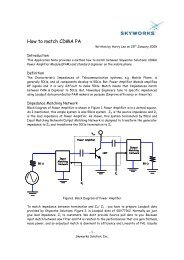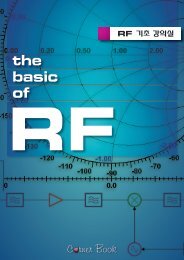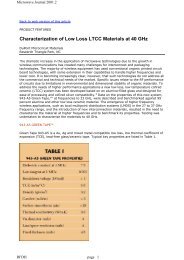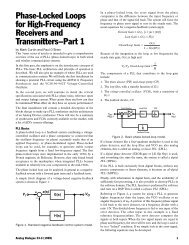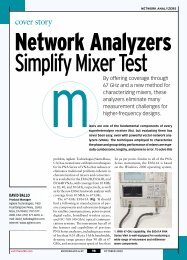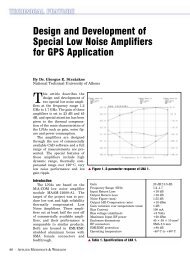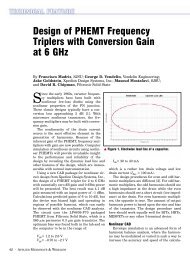Mathcad - ee217projtodonew2.mcd
Mathcad - ee217projtodonew2.mcd
Mathcad - ee217projtodonew2.mcd
Create successful ePaper yourself
Turn your PDF publications into a flip-book with our unique Google optimized e-Paper software.
Ballast Resistor Sizing<br />
The term ballast is of Swedish origin, where bal means " to bear," and llast means "load."<br />
Thus the term ballast means to bear the load. The load refers to a heavy weight placed at the<br />
bottom of ship to stabilize the ship in heavy waves. The term ballast is used here to describe a<br />
resistor, which is added to the circuit to provide stability. Most transistors given by a<br />
manufacturer are only conditionally stable. For this reason, and the reasons described above a<br />
ballast resistor is added to stabilize the transistor<br />
The following procedure is used to find the ballast resistor needed to make the amplifier<br />
unconditionally stable, or to provide the desired K factor. First, the procedure involves<br />
converting a given set of S parameters to ABCD parameters and multiplying them with the S<br />
parameters of a parallel resistor. Then the combination ABCD parameters are converted back<br />
into a new set of S parameters, which are used to find the K factor for the device. The value of<br />
resistance is swept to find the value need to meet a desired value of K factor.<br />
ABCD Parameters of a Parallel Resistor<br />
ABCD( R)<br />
1<br />
ohm<br />
R<br />
0<br />
1<br />
S to ABCD Parameter Calculation<br />
S2ABCD S,<br />
Z 0<br />
Note: The units are removed, for calculation purposes only<br />
1 S .<br />
1, 1<br />
1 S 22 ,<br />
S .<br />
12<br />
.<br />
2S 2,<br />
1<br />
,<br />
S 2,<br />
1<br />
ohm 1 S .<br />
1, 1<br />
1 S 22 ,<br />
S .<br />
.<br />
12<br />
Z .<br />
0<br />
2S 21 ,<br />
,<br />
S 21 ,<br />
Z 0 1 S .<br />
1, 1<br />
1 S 22 ,<br />
S .<br />
.<br />
12<br />
ohm<br />
.<br />
2S 21 ,<br />
1 S .<br />
1, 1<br />
1 S 22 ,<br />
S .<br />
12<br />
.<br />
2S 2,<br />
1<br />
,<br />
S 21 ,<br />
,<br />
S 2,<br />
1<br />
S2ABCD Sparam N, I C , s , 50 ohm<br />
=<br />
0.063 0.013i<br />
1.39. 10 4 1.384i . 10 3<br />
2.099 17.814i<br />
0.013 0.042i<br />
ABCD to S Parameter Calculation<br />
ABCD2S ABCD, Z 0 A ABCD 11 ,<br />
B ABCD 12 ,<br />
C ABCD 21 ,<br />
A<br />
D ABCD 22 ,<br />
1<br />
B . ohm<br />
Z 0<br />
Z 0<br />
C. D<br />
ohm<br />
.<br />
A<br />
B . ohm C. Z 0<br />
D<br />
Z 0 ohm<br />
2<br />
A<br />
2.( A. D BC . )<br />
B . ohm<br />
Z 0<br />
Z 0<br />
C. D<br />
ohm<br />
ABCD2S S2ABCD Sparam N, I C , s , 50 ohm , 50 ohm<br />
=<br />
0.537 0.038i<br />
0.129 4.151i<br />
1 0<br />
KwithR( S,<br />
R) K ABCD2S S2ABCD( S,<br />
50 ohm)<br />
. ohm ,<br />
1<br />
50 ohm<br />
R<br />
0.015 0.098i<br />
0.648 0.278i<br />
K Factor with Load Resistor<br />
KwithR Sparam N , I C , s , 1000 ohm = 1.082






